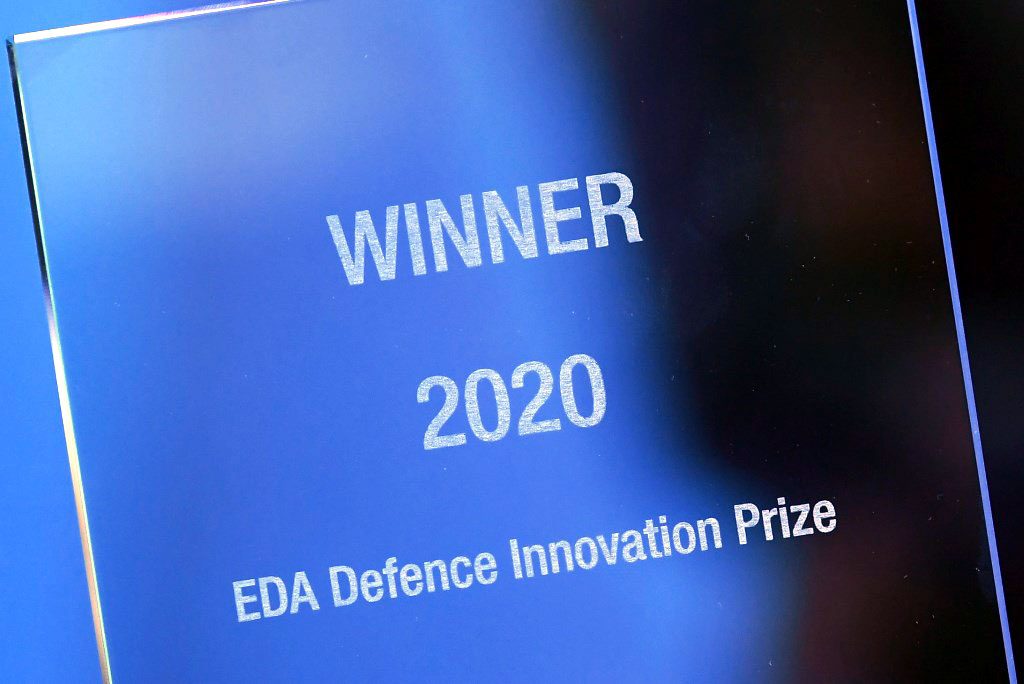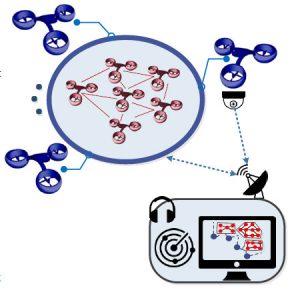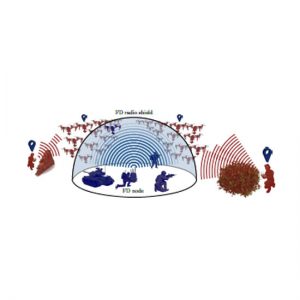
Defence Innovation Prize
On Day 1 of its Annual Conference the European Defence Agency awarded its Innovation Prize, an initiative launched in 2018 in order to stimulate Research and Technology (R&T), not so much among main defence industries, but more looking at start-ups, Academia, Research Centre, not always necessarily linked to the defence world.
The 2020 topic was ‘Countering Swarms of Unmanned Aerial Vehicles’, a threat considered serious by the European Union, especially when UAVs are used in swarms coordinated by Artificial Intelligence-based platforms. Countering UAVs is thus an important element for modern air defence as well as for force protection. The fact that this threat is among top considerations at EU level is highlighted by the presence of that subject in the revised EU Capability Development priorities, adopted in 2018, as well as in one of the six focus areas for potential future cooperation identified in the 2020 CARD.
“For the Defence Innovation Prize we look for innovative solutions and technologies for the detection and identification of swarms of small drones, mitigation measures incorporating the capability to intercept, disable and neutralise air vehicles, and minimise collateral damages,” Olli Ruutu, EDA Deputy Chief Executive, explained during the awards presentation. Underlining that R&T is of the highest importance to ensure Europe’s long-term capacity to innovate, the aim being to accelerate access to emerging disruptive technologies. “The prize also helps us in identifying areas in which additional investment is needed, to fully address an enhanced future defence capability need.”
The call for proposals for this year prize was issued in March 2020, and 12 projects were submitted, some of them being non-traditional actors in the defence world. Key criteria considered were the innovativeness of the proposal, as well as the fact that they could be implemented through a collaborative project, and that they would be affordable both in development and exploitation.
“Due to the excellence of two proposals we received, we decided to award the prize to two winners this year,” Mr. Ruutu explained. And the two winners, representing respectively Italy on one side and Estonia and Finland on the other, were the CIRA (Centro Italiano Ricerche Aerospaziali, Italian Aerospace Research Centre), and the team made of Rantelon and Tampere University.

Dr. Domenico Pascarella illustrated the CIRA project, titled ‘Drone-Swarm Tracking by an Intelligent Network for Mobile Proximal Sensing’, talking also on behalf of his team-colleagues Gabriella Gigante, Giuseppe Persechino and Angela Vozella. Known with the acronym SWADAR (Swarm Advanced Detection And Tracking) the system development, he explained, was triggered considering two aspects that make swarms of drones a serious threat: their autonomy and the swarming capacity, which limits tracking performances of conventional air defence systems. Some solutions do already exist, such as distributed radars, however according to Dr. Pascarella these have their limitations, i.e. due to the very limited Radar Cross Section (RCS) of a small drone, which allow them to follow swarms only intermittently and partially. The CIRA team has therefore proposed an innovative method for solving the swarm-tracking problem. “Swarms are characterised by two main features,” he explained, “the large number of drones, and their behaviour. A swarm can accomplish a complex task, i.e. a saturation attack, using simple behaviours, simple interactions among individual drones. SWADAR aims at taking advantage of those aspects, which are in the mean time the strength and the vulnerability of swarms.” SWADAR assesses that behaviour evaluating specific swarming metrics that can help identifying the attack scenario and predicting the course of action of the swarm attack. “The pre-condition for a successful counter-swarm action is to break the emergent behaviour of a swarm,” Dr. Pascarella continues, “and the SWADAR can thus suggest the swarming mechanism and the best suppression points, the most proper drones to hit in the swarm to disrupt its emergent behaviour with surgical accuracy.” To do so SWADAR builds an intelligent network for mobile proximal sensing, which is based on three pillars; the mobile proximal sensing, which is the instrument to overcome the limitations of conventional systems, because it employs more effective sensors such as LIDARs (Laser Imaging Detection and Ranging), visual and IR cameras; the second pillar is the sensors network that employs an array of sensor nodes, and not a centralised infrastructure, in order to perceive the attacking swarm from different perspectives, covering the spatial dispersion of the swarm; the last pillar is the automated recognition and cooperative scenario, a key element as it enables the fastest reaction, as starting from the tracks monitored it is possible to understand, applying Artificial Intelligence techniques such as Machine Learning, the unobserved behaviour of the swarm such as tactics, strategies, etc. providing the Common Operational Picture. “All this will be obtained using a defensive team of autonomous drones,” Pascarella continues, “The so-called Blue Team, which will thus represent the first line of protection, these drones being used not only for proximal sensing of the enemy swarm, but also for preliminary mitigation actions in order to neutralise some key intruders.” The last important element of the CIRA-developed SWADAR system is the Swarm Playbook Manager and the related simulator. “This will be essential to allow the SWADAR to be capable to face new and evolving threats, it will be the knowledge base, the library, which will be continuously updated with data from real incidents as well as with data coming from swarm simulations, hence the importance of the simulator,” Dr. Pascarella explained. The CIRA has established a five-year implementation roadmap aiming at delivering three different versions of the SWADAR prototype. The first one will be available in two year’s time while the final prototype will integrate the capability for an explainable Artificial Intelligence, an important item allowing the human to understand AI results, especially those concerning automatic classification of an attack. For the SWADAR fact-sheet, please click HERE.

Based in Tallin, Estonia, Rantelon Ltd. designs, produces and sells radio frequency electronic equipment. Teamed with Tampere University from Finland, it presented a project named ‘Full-Duplex Radio Technology for Enhanced Defence Capabilities Against Drone Swarms’. It was the turn of Mr. Karel Pärlin to take the floor to present the second award-winning technology. “We at Rantelon and at Tampere University have been working on full-duplex radio technology for some time already, with the backing of our national defence sectors,” he stated. The main methods for countering malicious drones are based on blocking the radio-frequency (RF) signals transmitted between drones and their controllers. The countermeasures usually include detecting drone signals and interfering with their reception. In the case of swarms, the link between the drones composing the swarm must also be targeted. Mr. Pärlin explains that Electronic Warfare (EW) systems cannot simultaneously receive and transmit on the same frequency with conventional radio technology, as the emitting component will blind the receiving one, something that is known as Self-Interference (SI). Spectrum-division methods, splitting the transmission either in different time slots on the same frequency, or on different albeit close frequencies, are used to obtain duplex communications. “Time division means detecting or tracking drone signals for some time and neutralising those signals in the remaining time, which means a trade-off between situational awareness and neutralisation efficiency. Our idea is to remove that trade-off exploiting that innovative concept of SI cancellation, a concept that has already been proven on an academic level in laboratory conditions by other research institutes around the world,” Mr. Pärlin said. The advantage of applying full-duplex radio technology to C-UAS applications is that it would allow combining different EW tasks simultaneously on the same frequency, i.e. detection, tracking and neutralisation, locating enemy drones and ground control stations while simultaneously neutralising radio-frequency links between them. “Moreover, full-duplex radios will enable our drones to transmit spoof satellite navigation signals to fool opponents systems about their location, while at the same time retaining the ability to correctly position themselves using satellite navigation,” the Rantelon representative said, adding that the C-UAS application is just one among many that can benefit from the full-duplex radio technology. “We believe that full-duplex radio technology could become a real radio-based superpower, as it allows our EW and communication systems to become multifunctional, and be capable to continuously adapt to the environment and threats.” He concluded explaining that SI technology is being proved in the laboratories, but that its integration into market ready products is still far away, as there is still to improve the power handling capability of current prototypes, extend their frequency range, and integrating those prototypes with specific applications; to do so the team plans to engage different experts to determine which applications and use cases will provide the most advantages in the first place. Mr. Pärlin also underlined the importance of creating a European full-duplex cooperation network. For the Full-Duplex radio technology fact-sheet, please click HERE.


